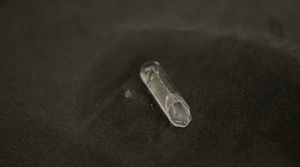Argon
 Argon, after being frozen with liquid nitrogen, melting and subliming at the same time, at standard conditions. | |||||
| General properties | |||||
|---|---|---|---|---|---|
| Name, symbol | Argon, Ar | ||||
| Appearance | Colorless gas exhibiting a lilac/violet glow when placed in an electric field | ||||
| Argon in the periodic table | |||||
| |||||
| Atomic number | 18 | ||||
| Standard atomic weight (Ar) | 39.948(1) | ||||
| Group, block | , p-block | ||||
| Period | period 3 | ||||
| Electron configuration | [Ne] 3s2 3p6 | ||||
per shell | 2, 8, 8 | ||||
| Physical properties | |||||
| Colorless | |||||
| Phase | Gas | ||||
| Melting point | 83.81 K (−189.34 °C, 308.81 °F) | ||||
| Boiling point | 87.302 K (−185.848 °C, −302.526 °F) | ||||
| Density at (0 °C and 101.325 kPa) | 1.784 g/L | ||||
| when liquid, at | 1.3954 g/cm3 | ||||
| Triple point | 83.8058 K, 68.89 kPa | ||||
| Critical point | 150.687 K, 4.863 MPa | ||||
| Heat of fusion | 1.18 kJ/mol | ||||
| Heat of | 6.53 kJ/mol | ||||
| Molar heat capacity | 20.85 J/(mol·K) | ||||
| pressure | |||||
| Atomic properties | |||||
| Oxidation states | 0 | ||||
| energies |
1st: 1520.6 kJ/mol 2nd: 2665.8 kJ/mol 3rd: 3931 kJ/mol | ||||
| Covalent radius | 106±10 pm | ||||
| Van der Waals radius | 188 pm | ||||
| Miscellanea | |||||
| Crystal structure | face-centered cubic (fcc) | ||||
| Speed of sound | 323 m/s (gas, at 27 °C) | ||||
| Thermal conductivity | 17.72×10−3 W/(m·K) | ||||
| Magnetic ordering | Diamagnetic | ||||
| CAS Registry Number | 7440-37-1 | ||||
| Discovery and first isolation | Lord Rayleigh and William Ramsay (1894) | ||||
Argon is a noble gas with the symbol Ar and the atomic number 18. It forms no compounds accessible to the home chemist due to its inertness, which makes it suitable for inert atmospheres.
Contents
[hide]Properties
Physical
Argon is a colorless, odorless gas at standard conditions, with a boiling point of -185.848 °C and a melting point of −189.34 °C. It is heavier than air, with an density of 1.784 g/L. Unlike nitrogen, argon is 2.5 times more soluble in water, solubility similar to that of oxygen.
Chemical
Argon is chemically inert under most conditions and forms no confirmed stable compounds at room temperature. At 8 K, argon reacts with hydrogen fluoride, on a cesium iodide surface, resulting in argon fluorohydride, HArF, which is stable only under 17 K. These compounds are out of reach for the amateur chemist, and don't have any other uses besides research.
Availability
Argon is used as a shielding gas in welding, so many gas or welding supply stores will sell and rent out cylinders of pure argon or mixtures of argon and carbon dioxide (the more argon in the mixture, the more expensive it is).
A crude form of argon that is accessible to most people can be obtained from light bulbs, which may contain argon or a mixture of argon and nitrogen. This can be done by holding the bulb underwater, and slipping an open plastic bag around the bulb so that no air is in the bag. After sealing the bag, the light bulb can be broken, causing the inert gas inside to rise to the top while still trapped in the bag.
Preparation
Argon can be separated from liquified air, although the process is very consuming and complicated due to argon's narrow liquid temperature range. It's best to buy argon cylinders.
Uses
As it takes no role in any chemistry, argon can be used as an inert atmosphere.
Creating an inert atmosphere in a home chemistry setting is difficult, and not often done. Nitrogen is usually used in the rare case it is attempted, and argon is called upon when nitrogen and carbon dioxide are unsuitable, as both carbon dioxide and nitrogen are cheaper gases than argon. For some processes that cannot be done in either of these atmospheres, the more expensive and difficult-to-find argon must be used. As argon is heavier than air, any container that is supposed to hold an argon atmosphere should have the opening above.
Argon is the choice gas in Schlenk lines and gloveboxes.
The most common use of argon is likely the preservation of samples or presentation in element collections, especially for air-sensitive elements.
Handling
Safety
Argon is inert and will not react with any compounds, making it safe to use. It may pose an asphyxiation hazard in closed rooms. Since it's heavier than air, it will accumulate on the lower part of a room.
Storage
Compressed argon should be stored away from heat.
Disposal
Argon can be released in atmosphere outside. Best to avoid closed spaces.